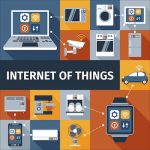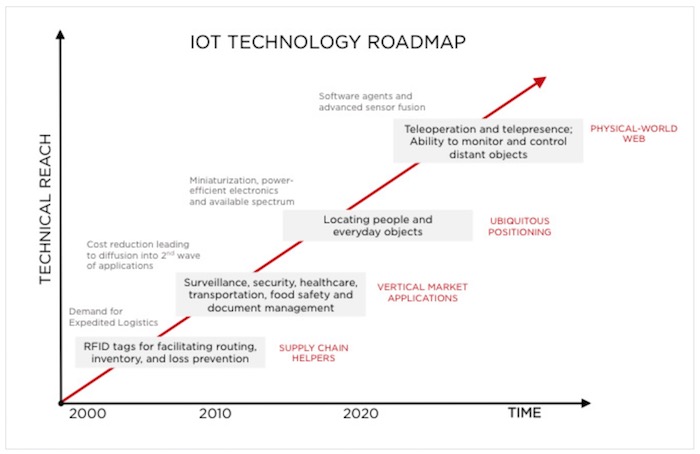 As mentioned in part one — What is the Internet of Things — this series is not intended to be an engineering textbook on the IoT and its enabling technologies. However, the IoT’s technology road map is shown in Figure 2 [19] and we will present some general background on the IoT’s technical landscape to inform our IP strategy discussion (forthcoming).
As mentioned in part one — What is the Internet of Things — this series is not intended to be an engineering textbook on the IoT and its enabling technologies. However, the IoT’s technology road map is shown in Figure 2 [19] and we will present some general background on the IoT’s technical landscape to inform our IP strategy discussion (forthcoming).

Figure 2: Technology Roadmap: The Internet of Things
A. BIG DATA
As more things (or “smart objects”) are connected to the IoT, more data is collected from them in order to perform analytics to determine trends and associations that lead to insights. For example, an oil well equipped with 20-30 sensors can generate 500,000 data points every 15 seconds20, a jetliner with 6,000 sensors generates 2.5 terabytes of data per day [21], and the more than 46 million smart utility meters installed in the U.S. generate more than 1 billion data points each day. [22] Thus, the term “big data” refers to these large data sets that need to be collected, stored, queried, analyzed and generally managed in order to deliver on the promise of the IoT — insight!
Further compounding the technical challenges of big data is the fact that IoT systems must deal with not only the data collected from smart objects, but also ancillary data that is needed
to properly perform such analytics (e.g., public and private data sets related to weather, GIS, financial, seismic, map, GPS, crime, etc.). Thus, as more smart objects come online, at least three metrics (“the three V’s”) are typically used by IoT operators to describe the big data they handle: volume (i.e., the amount of data they collect from their IoT sensors measured in gigabytes, terabytes and petabytes); velocity (i.e., the speed at which data is collected from the sensors); and variety (i.e., the di ering types of structured and unstructured data collected, especially when compared to video and picture files as is typical within the consumer Internet).
B. DIGITAL TWIN
Another consequence of the growing and evolving IoT is the concept of a “digital twin,” introduced in 2003 by John Vickers, manager of NASA’s National Center for Advanced Manufacturing. [23 ]The concept refers to a digital copy of a physical asset (i.e., a smart object within the IoT), that lives and evolves in a virtual environment over the physical asset’s lifetime. That is, as the sensors within the object collect real-time data, a set of models forming the digital twin is updated with all of the same information. Thus, an inspection of the digital twin would reveal the same information as a physical inspection of the smart object itself – albeit remotely. The digital twin of the smart object can then be studied to not only optimize operations of the smart object through reduced maintenance costs and downtime, but to improve the next generation of its design.
C. CLOUD COMPUTING
As the word “cloud” is often used as a metaphor for the Internet, “cloud computing” refers to
being able to access computing resources via the Internet rather than traditional systems where computing hardware is physically located on the premises of the user and any software applications are installed on such local hardware. More formally, “cloud computing” is defined as:
“[A] model for enabling ubiquitous, convenient, on-demand network access to a shared pool
of configurable computing resources (e.g., networks, servers, storage, applications, and services) that can be rapidly provisioned and released with minimal management e ort or service provider interaction.” [24]
Cloud computing – and its three service models of Software as a Service (SaaS), Platform as a Service (PaaS) and Infrastructure as a Service (IaaS) – are important to the IoT because it allows any user with a browser and an Internet connection to transform smart object data
into actionable intelligence. That is, cloud computing provides “the virtual infrastructure for utility computing integrating applications, monitoring devices, storage devices, analytics tools, visualization platforms, and client delivery… [to] enable businesses and users to access [IoT-enabled] applications on demand anytime, anyplace and anywhere.” [25]
D. SENSORS
Central to the functionality and utility of the IoT are sensors embedded in smart objects. Such sensors are capable of detecting events or changes in a specific quantity (e.g., pressure), communicating the event or change data to the cloud (directly or via a gateway) and, in some circumstances, receiving data back from the cloud (e.g., a control command) or communicating with other smart objects. Since 2012, sensors have generally shrunk in physical size and thus have caused the IoT market to mature rapidly. More specifically: “Technological improvements created microscopic scale sensors, leading to the use of technologies like Microelectromechanical systems (MEMS). This meant that sensors were now small enough to be embedded into unique places like clothing or other [smart objects].” [26]
E. COMMUNICATIONS
With respect to sending and receiving data, wired and wireless communication technologies have also improved such that nearly every type of electronic equipment can provide data connectivity. This has allowed the ever-shrinking sensors embedded in smart objects to send and receive data over the cloud for collection, storage and eventual analysis.
The protocols for allowing IoT sensors to relay data include wireless technologies such as RFID, NFC, Wi-Fi, Bluetooth, Bluetooth Low Energy (BLE), XBee, ZigBee, Z-Wave, Wireless M-Bus, SIGFOX and NuelNET, as well as satellite connections and mobile networks using GSM, GPRS, 3G, LTE, or WiMAX. [27] Wired protocols, useable by stationary smart objects, include Ethernet, HomePlug, HomePNA, HomeGrid/G.hn and LonWorks, as well as conventional telephone lines. [28]
F. ANALYTICS SOFTWARE
Within the IoT ecosystem, Application Service Providers (ASPs) – which may or may not di er from the companies who sell and service the smart objects – provide software to companies that can transform “raw” machine (big) data collected from smart objects into actionable intelligence (or insight). Generally speaking, such software performs data mining and employs mathematical models and statistical techniques to provide insight to users. That is, events, trends and patterns are extracted from big data sets in order to present the software’s end-users with insight
in the form of portfolio analysis, predictions, risk analysis, automations and corrective, maintenance and optimization recommendations. In many cases, the ASPs may provide general analytical software or software targeting specific industries or types of smart objects.
G. EDGE DEVICES
Not shown in our simplistic IoT ecosystem of Figure 1 is exactly how the smart objects embedded with sensors connect via the Internet to the various service provider systems. The answer is via “edge devices” – any device such
as a router, routing switch, integrated access device (IAD), multiplexer, or metropolitan area network (MAN) and wide area network (WAN) access device which provides an entry point from the global, public Internet into an ASP’s or other enterprise’s private network. [29] In Industry 4.0, these edge devices are becoming smarter at processing data before such data even reaches an enterprise network’s backbone (i.e., its core devices and cloud data centers). For example, edge devices may translate between di erent network protocols, and provide first-hop security, initial quality of service (QoS) and access/ distribution policy functionality. [30]
TO BE CONTINUED… Up next is discussion of IoT’s implications for IP law practice.
______________
[19] Office of the National Director of Intelligence, Global Trends 2025: A Transformed World (Nov. 20, 2008) at Appendix F, p.1 (the roadmap “highlights the timing, features, and applications of significant technology milestones that would be necessary for developers of this technology to achieve if successful (equivalent to commercial) application—and possible disruption—is to occur by 2025”).
[20] Stacey Higginbotham, BP Teams with GE to Make its Oil Wells Smart, Fortune (Jul. 8, 2015).
[21] Bernard Marr, That’s Data Science: Airbus Puts 10,000 Sensors in Every Single Wing!, Data Science Central (Apr. 9, 2015).
[22] Katherine Tweed, Smart Meters Deliver 1 Billion Data Points Daily, Greentech Media (Sept. 13, 2013).
[23] See Michael W. Grieves, Virtually Perfect: Driving Innovative and Lean Products through Product Lifecycle Management (Space Coast Press, ISBN:0982138008, 2011) at 133.
[24] Natl. Inst. of Standards & Tech. (U.S. Dept. of Commerce), The NIST Definition of Cloud Computing, Special Publ. 800-145 (Sept. 2011).
[25] David Canellos, How the “Internet of Things” Will Feed Cloud Computing’s Next Evolution, Cloud Security Alliance Blog (June 5, 2013).
[26] Frédéric Combaneyre, Understanding Data Streams in IoT, SAS White Paper (2015).
[27] See generally, Wikibooks, I Dream of IoT (last visited Apr. 12, 2016) at Chp. 6.
[28] Id.
[29] Wikipedia, Edge Device (visited Aug. 19, 2016).
[30] Orhan Ergun, Edge Devices are the Brains of the Network, Network Computing (Apr. 23, 2014).

![[IPWatchdog Logo]](https://ipwatchdog.com/wp-content/themes/IPWatchdog%20-%202023/assets/images/temp/logo-small@2x.png)


![[Advertisement]](https://ipwatchdog.com/wp-content/uploads/2024/05/Quartz-IP-May-9-2024-sidebar-700x500-1.jpg)
![[Advertisement]](https://ipwatchdog.com/wp-content/uploads/2024/04/Patent-Litigation-Masters-2024-sidebar-last-chance-700x500-1.jpg)
![[Advertisement]](https://ipwatchdog.com/wp-content/uploads/2024/05/Patent-Portfolio-Management-2024-sidebar-super-early-bird-with-button-700x500-1.jpg)

![[Advertisement]](https://ipwatchdog.com/wp-content/uploads/2021/12/WEBINAR-336-x-280-px.png)
![[Advertisement]](https://ipwatchdog.com/wp-content/uploads/2021/12/2021-Patent-Practice-on-Demand-recorded-Feb-2021-336-x-280.jpg)
![[Advertisement]](https://ipwatchdog.com/wp-content/uploads/2021/12/Ad-4-The-Invent-Patent-System™.png)







Join the Discussion
No comments yet.